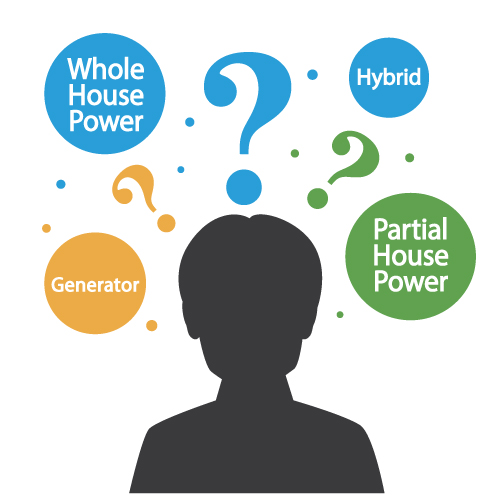Battery Backup: Whole House VS Essential Loads
When considering solar power with a battery storage backup system, you will have to decide if you want Whole House Power, rather than Partial House Power, during an outage. Either can be wired in various ways depending on the inverter(s).
To keep it simple, the tradeoff is cost vs. capability:
- Whole House = more expensive (multiple inverters, larger battery)
- Partial House = more economical (one hybrid inverter, smaller battery)
Partial house power is also called essential load or critical load power in that you power the basics like a fridge, lights, outlets, wifi router, and small 120Vac appliances.
Whole house power (e.g., 50 Amps or more) may require multiple inverters. Each inverter has an AC output Amp rating for off-grid use, generally 25A to 33A continuous power, with burst capability. To have whole-house power, you need multiple battery inverters stacked together. You can have two inverters, one for grid-tied solar and one for an off-grid battery; this is called AC-coupled. Power from panels is DC, the power to the solar inverter is AC, the power to the battery inverter is AC/DC, and then power to the battery is DC.
There are also hybrid inverters that connect the solar and the battery in the same unit; this is called DC-coupled. DC power flows from the panels and directly into the battery, where the DC power is stored. These hybrid inverters have an integrated transfer switch and connection for a "critical load" sub-panel. The output Amps are based on the inverter capability, generally 25A to 33A continuous power, with burst capability. You can stack multiple hybrid inverters for higher output.
Some hybrid and off-grid battery inverters also have input to connect a generator. For this type of battery storage backup system, you'd have four power sources; grid, solar, battery, and generator. While having multiple power sources is an attractive option, keep in mind that there is a reflective cost with setting up a power backup system like this, which might not be ideal for your battery storage backup system.
For cost reasons, most people choose partial house power. That means the fridge, some lights, outlets, 120V appliances, and some 240V appliances which use less than 30Amps. In a Partial House Power battery storage backup system, you won't be sitting in your heat or AC cooled home, but you will have light, internet, and TV with chilled food in the fridge/freezer and your wallet will like this cost minded approach.
